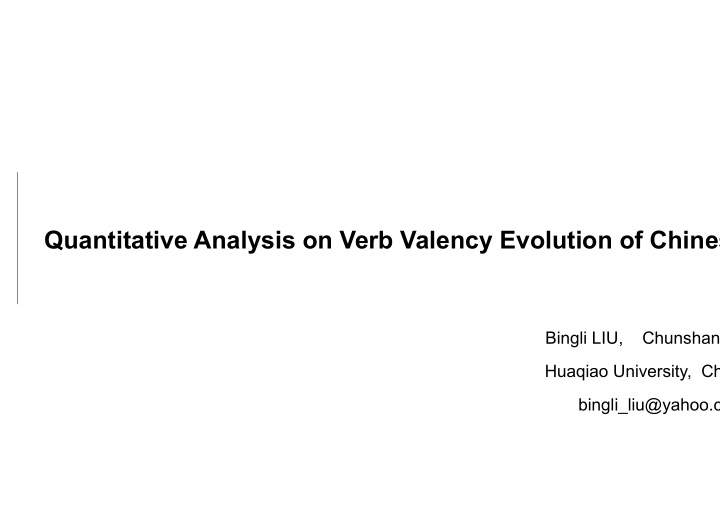



Quantitative Analysis on Verb Valency Evolution of Chinese Bingli LIU, Chunshan Xu Huaqiao University, China bingli_liu@yahoo.co
SECTIONS 01/ 02/ Question Methods and Materials 03/ 04/ Conclusion Results and Discussion
1 Question PART 01 1.Are there any change in the verb valence during the long history period of Chinese?
1 Question PART 01 2.If itis, is it a small change or a big one?
2 Methods and Materials PART 02
2. Methods and Materials • The ancient classical Chinese dates back from 1600 BC to 618 AD; • T he ancient vernacular Chinese dates back from 618 to 1911; • The modern vernacular Chinese dates back from 1912 to now.
2. Methods and Materials Corpora composition: • The ancient classical Chinese : Zuozhuan (narrative chronicle), Lv Shi Chun Qiu (a book on political theory), Liu Tao (a book on military strategies), Shangshu (government archives), Mencius (quotations from a sage), Xunzi (a book on philo ' sophical treatise), Zhanguoce, Shiji, Han Shu, Sanguozhi, Houhanshu (5 books on history), Guoxiaoshuogoucheng, Shishuoxinyu (novels)
2. Methods and Materials • T he ancient vernacular Chinese : Dunhuangbianwenji, Qingpingshantanghuaben, Xixiangji, Sanguoyanyi, Chukepaianjinqi, Erkepaianjinqi, Shuihuzhuan and Xiyouji (they are all novels or playbooks of Chinese) • The modern vernacular Chinese : samples from novel s.
2. Methods and Materials
2. Methods and Materials • Ten verbs are selected because of their diachronic lexeme stability: • ⾛赱 (walk) , 听 (listen), 到 (arrive), 爱 (love), 有 (have), 为 (be), 能 (can), 来 (come), 使 (let) , 愿 (wish).
2. Methods and Materials ancient classical ancient vernacular modern vernacular Chinese Chinese Chinese 到 (arrive) 166 52 102 来 (come) 91 97 78 爱 (love) 98 51 70 能 (can) 211 100 100 使 (let) 210 62 97 听 (listen) 71 76 72 为 (be) 201 100 100 有 (have) 207 116 104 愿 (wish) 53 108 151 ⾛ (walk) 75 51 58 Total 1383 813 932 Table 1. Number of sentence containing the 10 verbs
2. Methods and Materials • Criteria to select sentences: • (1) The verb is used in the active voice • (2) The verb has similar semantic meaning across different periods
2. Methods and Materials Then we begin to annotate the sentences which include the verbs chosen according to the dependency grammar.
3 Results and Discussion PART 03
3. Results and Discussion Figure 1. Average ratio of the complex constituent in the subject argument ( % )
3. Results and Discussion Figure 2. Average ratio of the complex constituent in the object argument ( % )
3. Results and Discussion
3. Results and Discussion Figure 3. Average Ratio of other constituent ( % )
3. Results and Discussion Figure 4. Average Ratio of the adjective in the sentence (%)
3. Results and Discussion Figure 5. The valency evolution of the main verbs in the three forms of Chinese (%)
4 Conclusion PART 04
4. Conclusion • Chinese syntax has a tendency toward increasing complexity. • T he ancient classical Chinese and the ancient vernacular Chinese are more similar in valency patterns. • The transition from the ancient vernacular Chinese to the modern vernacular Chinese seems to be drastically increased in the syntactic complexity.
Thank you for your attention !
Recommend
More recommend